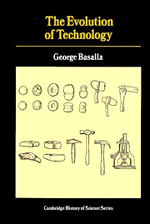Book contents
- Frontmatter
- Contents
- Preface
- I Diversity, Necessity, and Evolution
- II Continuity and Discontinuity
- III Novelty (1): Psychological and Intellectual Factors
- IV Novelty (2): Socioeconomic and Cultural Factors
- V Selection (1): Economic and Military Factors
- VI Selection (2): Social and Cultural Factors
- VII Conclusion: Evolution and Progress
- Bibliography
- Sources of Quotations
- Index
V - Selection (1): Economic and Military Factors
Published online by Cambridge University Press: 05 August 2014
- Frontmatter
- Contents
- Preface
- I Diversity, Necessity, and Evolution
- II Continuity and Discontinuity
- III Novelty (1): Psychological and Intellectual Factors
- IV Novelty (2): Socioeconomic and Cultural Factors
- V Selection (1): Economic and Military Factors
- VI Selection (2): Social and Cultural Factors
- VII Conclusion: Evolution and Progress
- Bibliography
- Sources of Quotations
- Index
Summary
Introduction
Because there is an excess of technological novelty and consequently not a close fit between invention and wants or needs, a process of selection must take place in which some innovations are developed and incorporated into a culture while others are rejected. Those that are chosen will be replicated, join the stream of made things, and serve as antecedents for a new generation of variant artifacts. Rejected novelties have little chance of influencing the future shape of the made world unless a deliberate effort is made to bring them back into the stream (Figure V. 1).
If these remarks recall the notion of evolution by natural selection, they are meant to do so. There are, however, crucial differences between artifactual and organic evolution that must be mentioned before any further use is made of the selection analogy.
Central to organic evolution is the variability that arises from mutation and from the recombination of the parental genes in sexual reproduction. The resulting variant offspring are subject to natural selection, which permits some, but not all, of the variants to survive, reproduce, and pass on their genetic information. The offspring, which have the potential to move in many different evolutionary directions, are selected by the totality of conditions — environmental, biological, social — that prevail at the time of their appearance.
- Type
- Chapter
- Information
- The Evolution of Technology , pp. 135 - 168Publisher: Cambridge University PressPrint publication year: 1989



